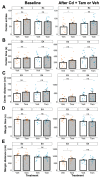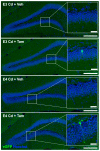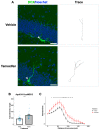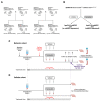Inducible and Conditional Activation of Adult Neurogenesis Rescues Cadmium-Induced Hippocampus-Dependent Memory Deficits in ApoE4-KI Mice
- PMID: 37298071
- PMCID: PMC10253189
- DOI: 10.3390/ijms24119118
Inducible and Conditional Activation of Adult Neurogenesis Rescues Cadmium-Induced Hippocampus-Dependent Memory Deficits in ApoE4-KI Mice
Abstract
The apolipoprotein E (ApoE) gene is a genetic risk factor for late-onset Alzheimer's disease, in which ε4 allele carriers have increased risk compared to the common ε3 carriers. Cadmium (Cd) is a toxic heavy metal and a potential neurotoxicant. We previously reported a gene-environment interaction (GxE) effect between ApoE4 and Cd that accelerates or increases the severity of the cognitive decline in ApoE4-knockin (ApoE4-KI) mice exposed to 0.6 mg/L CdCl2 through drinking water compared to control ApoE3-KI mice. However, the mechanisms underlying this GxE effect are not yet defined. Because Cd impairs adult neurogenesis, we investigated whether genetic and conditional stimulation of adult neurogenesis can functionally rescue Cd-induced cognitive impairment in ApoE4-KI mice. We crossed either ApoE4-KI or ApoE3-KI to an inducible Cre mouse strain, Nestin-CreERTM:caMEK5-eGFPloxP/loxP (designated as caMEK5), to generate ApoE4-KI:caMEK5 and ApoE3-KI:caMEK5. Tamoxifen administration in these mice genetically and conditionally induces the expression of caMEK5 in adult neural stem/progenitor cells, enabling the stimulation of adult neurogenesis in the brain. Male ApoE4-KI:caMEK5 and ApoE3-KI:caMEK5 mice were exposed to 0.6 mg/L CdCl2 throughout the experiment, and tamoxifen was administered once Cd-induced impairment in spatial working memory was consistently observed. Cd exposure impaired spatial working memory earlier in ApoE4-KI:caMEK5 than in ApoE3-KI:caMEK5 mice. In both strains, these deficits were rescued after tamoxifen treatment. Consistent with these behavioral findings, tamoxifen treatment enhanced adult neurogenesis by increasing the morphological complexity of adult-born immature neurons. These results provide evidence for a direct link between impaired spatial memory and adult neurogenesis in this GxE model.
Keywords: Alzheimer’s disease; adult neurogenesis; cadmium; gene–environment interaction; neurotoxicity.
Conflict of interest statement
The authors declare no conflict of interest.
Figures











Similar articles
-
The Effects of Gene-Environment Interactions Between Cadmium Exposure and Apolipoprotein E4 on Memory in a Mouse Model of Alzheimer's Disease.Toxicol Sci. 2020 Jan 1;173(1):189-201. doi: 10.1093/toxsci/kfz218. Toxicol Sci. 2020. PMID: 31626305 Free PMC article.
-
Inducible and Conditional Stimulation of Adult Hippocampal Neurogenesis Rescues Cadmium-Induced Impairments of Adult Hippocampal Neurogenesis and Hippocampus-Dependent Memory in Mice.Toxicol Sci. 2020 Sep 1;177(1):263-280. doi: 10.1093/toxsci/kfaa104. Toxicol Sci. 2020. PMID: 32617577 Free PMC article.
-
Gene-environment interaction between lead and Apolipoprotein E4 causes cognitive behavior deficits in mice.Mol Neurodegener. 2017 Feb 7;12(1):14. doi: 10.1186/s13024-017-0155-2. Mol Neurodegener. 2017. PMID: 28173832 Free PMC article.
-
Apolipoprotein E isoforms in Alzheimer's disease pathology and etiology.Microsc Res Tech. 2000 Aug 15;50(4):278-81. doi: 10.1002/1097-0029(20000815)50:4<278::AID-JEMT5>3.0.CO;2-T. Microsc Res Tech. 2000. PMID: 10936880 Review.
-
Apolipoprotein E and oxidative stress in brain with relevance to Alzheimer's disease.Neurobiol Dis. 2020 May;138:104795. doi: 10.1016/j.nbd.2020.104795. Epub 2020 Feb 6. Neurobiol Dis. 2020. PMID: 32036033 Free PMC article. Review.
Cited by
-
Cadmium inhibits calcium activity in hippocampal CA1 neurons of freely moving mice.Toxicol Sci. 2024 Jun 26;200(1):199-212. doi: 10.1093/toxsci/kfae048. Toxicol Sci. 2024. PMID: 38579196 Free PMC article.
-
Memory circuits in dementia: The engram, hippocampal neurogenesis and Alzheimer's disease.Prog Neurobiol. 2024 May;236:102601. doi: 10.1016/j.pneurobio.2024.102601. Epub 2024 Apr 1. Prog Neurobiol. 2024. PMID: 38570083 Free PMC article. Review.
-
Intervention Role of APOE in CNS Diseases: APOE Actions and APOE Neurogenesis Capability.Mol Neurobiol. 2025 May 22. doi: 10.1007/s12035-025-05028-8. Online ahead of print. Mol Neurobiol. 2025. PMID: 40402407 Review.
-
Agonism of MT1 and MT2 Receptor Mitigates Oxidative Insult, Neuroinflammation, and Cerebral Injury in Cadmium Chloride Treated Animals.Neurochem Res. 2025 Jun 10;50(3):193. doi: 10.1007/s11064-025-04451-6. Neurochem Res. 2025. PMID: 40493137
-
Associations of Environmental Exposure to Arsenic, Manganese, Lead, and Cadmium with Alzheimer's Disease: A Review of Recent Evidence from Mechanistic Studies.J Xenobiot. 2025 Mar 24;15(2):47. doi: 10.3390/jox15020047. J Xenobiot. 2025. PMID: 40278152 Free PMC article. Review.
References
MeSH terms
Substances
Grants and funding
LinkOut - more resources
Full Text Sources
Medical
Miscellaneous

